
The Solar-Terrestrial Centre of Excellence (STCE) is a collaborative network of the Belgian Institute for Space Aeronomy, the Royal Observatory of Belgium and the Royal Meteorological Institute of Belgium.
 |
Published by the STCE - this issue : 8 Nov 2013. The Solar-Terrestrial Centre of Excellence (STCE) is a collaborative network of the Belgian Institute for Space Aeronomy, the Royal Observatory of Belgium and the Royal Meteorological Institute of Belgium. |
| Archive of the newsletters | Subscribe to this newsletter by mail |
Every year, many companies organize activities for their personnel in order to have some fun and to strengthen the team spirit. Late October, some sunspot groups got the same idea. However, their idea of a fun team building activity was quite different: Together, they wanted to destroy a nearly million km long solar filament. This spectacular movie at http://www.youtube.com/watch?v=Lecb6oEme5E reveals how they did it.
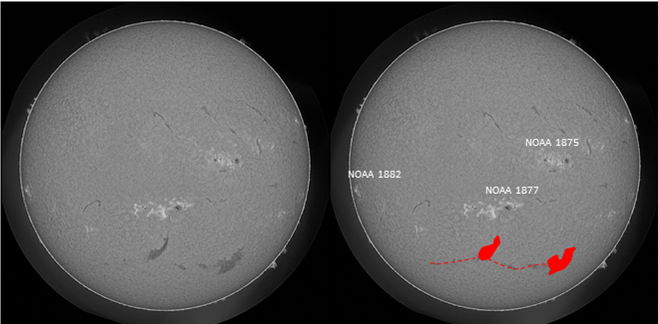
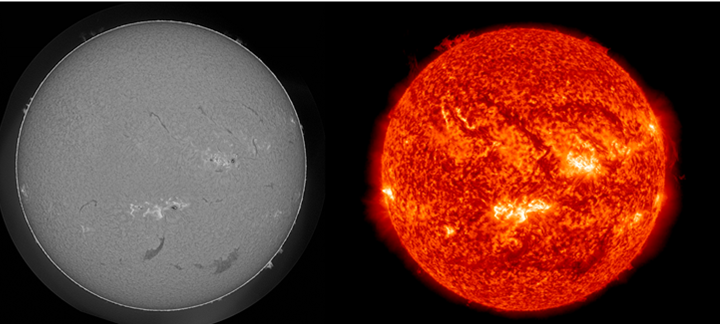
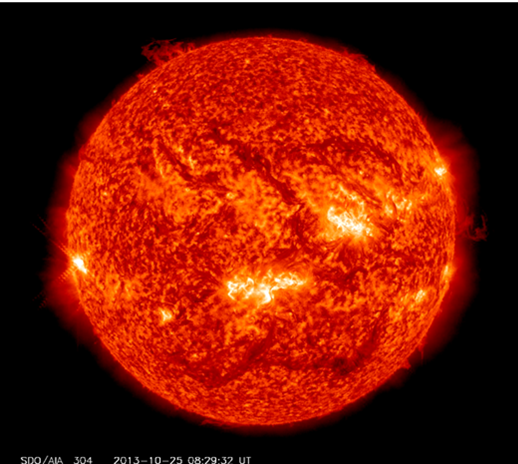

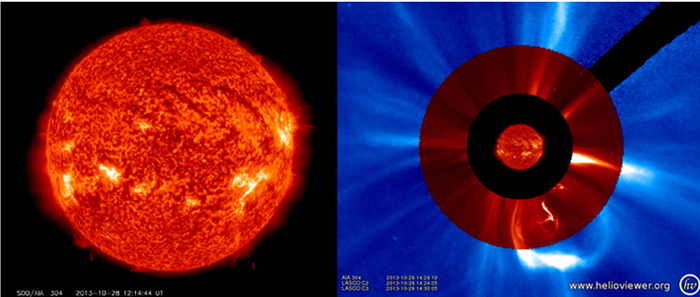
Credits - Images were taken from the GONG H-alpha Network (http://halpha.nso.edu/ ), SDO (http://sdo.gsfc.nasa.gov/ ), SOHO (http://sohowww.nascom.nasa.gov/ ) and Helioviewer (www.helioviewer.org/ ).
Introduction - On 5 November 2013, the new SILSO webpages (WDC Sunspot) at http://www.sidc.be/silso were officially released. Simultaneously, the new name and logo for the WDC were also announced.
Over the past two years, a profound modernization of the sunspot index processing has been undertaken. So far, this evolution remained largely invisible to our users but in the coming months, it will lead to improved and expanded data products. Moreover, a full revision of the historical sunspot index series itself is also in preparation, following a series of Sunspot Number Workshops that started in 2011 (http://ssnworkshop.wikia.com/wiki/Home). In view of this major step, we have now created a brand new website that is destined to become the central portal for accessing the sunspot index data and other long-term records of solar activity: http://www.sidc.be/silso.
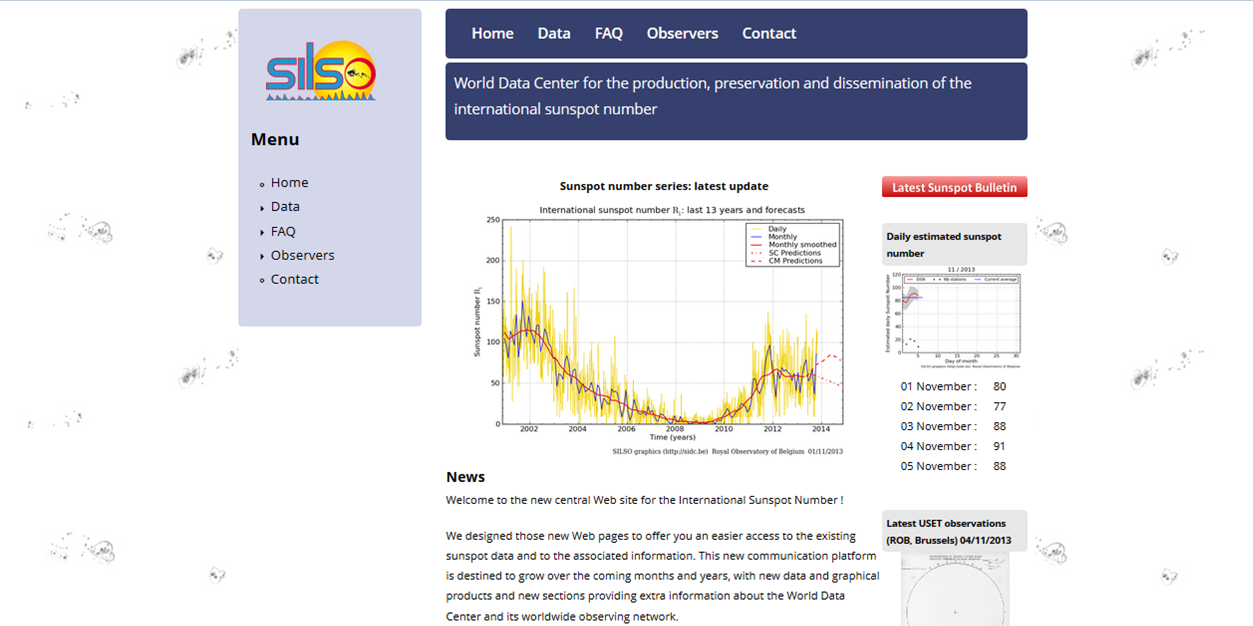
In order to reflect this major milestone and the new scope of our World Data Center (WDC), we also decided to adopt a new name and acronym: SILSO for "Sunspot Index and Long-term Solar Observations", with a new logo.
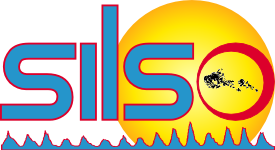
SILSO also becomes our new official name as member of the ICSU World Data System (http://www.icsu-wds.org/). The WDC-SILSO remains hosted at the SIDC Brussels. Since 1981, the SIDC (originally "Sunspot Index Data Center") evolved to become the overarching name of the current Solar physics team of the Royal Observatory of Belgium ("Solar Influences Data analysis Center"). In the very wide range of activities and projects encompassed by the current SIDC, SILSO now gathers all long-term ground-based services and research activities addressing the specific needs of our users interested primarily in the evolution of solar activity and Sun-Earth relations over long timescales.
It is thus with pleasure that we publicly release our new SILSO website: http://www.sidc.be/silso We designed those new webpages to provide a user-friendly access to the existing sunspot data and to the associated information. This new communication platform is destined to grow over the coming weeks and months, with new data and graphical products and new sections providing additional information about the World Data Center, its methods and its worldwide observing network.
In order to avoid an abrupt transition for our users, the current initial version still provides our data files in their traditional format, but it already includes various additional features: improved data documentation, a dynamical plot of the latest estimated international sunspot number (EISN) updated every 5 minutes, files in CSV-format (for direct import in your favorite spreadsheet) and a FAQ section.
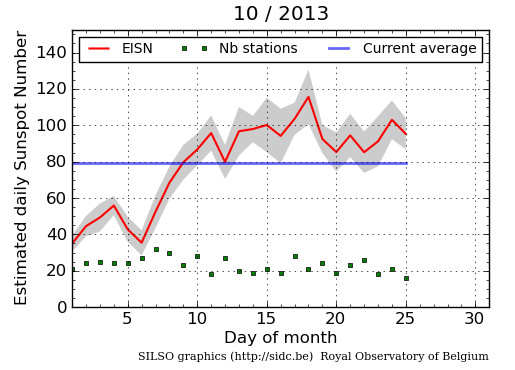
Please explore the new sections and don't hesitate to make comments and suggestions. New ideas are always welcome and we will strive to implement them while the site is maturing. Our future plans include e.g. SILSO network statistics, error bars on the sunspot numbers and the extension of the group number series (Hoyt and Schatten, 1998).
So, please bookmark this new central "Sunspot" website and stay tuned for upcoming changes and new features!
Frédéric Clette
WDC Director
frederic.clette@oma.be
High intensity X-ray flares were observed from October 28 to November 3, in total 2 X and 10 M flares. The X-ray back ground radiation was even in the C-level on October 28 and 29. October 30 was the day with less activity compared to the rest of the week: only C-flares. The X-ray radiation curve peaked again into the M-level from Halloween to November 3: 1 M flare a day.

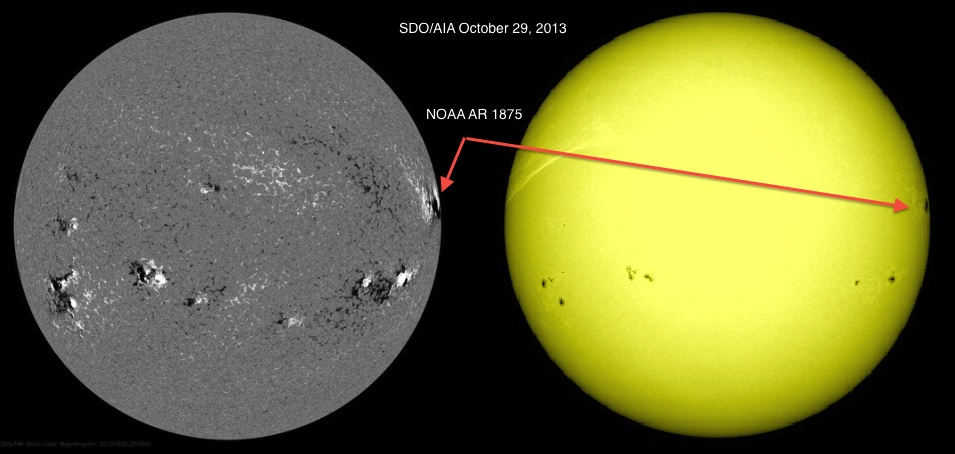
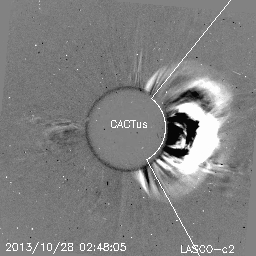
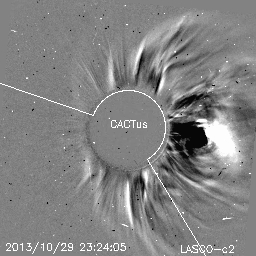
A few other halo CMEs were registered: the October 28 CME coming into the field of view (FOV) of LASCO/C2 at 15:36 UT (check http://sidc.oma.be/cactus/catalog/LASCO/2_5_0/qkl/2013/10/CME0171/CME.html) and two backsided CMEs on November 2 (in FOV of LASCO/C2 at 5:00 UT and 8:12 UT). All CMEs were associated with an event originating from NOAA AR 11875.
Solar wind data measured by ACE indicated the arrival of a small shock around 7:00 UT On October 29, related to the arrival of the CMEs of October 25. An increase in the solar wind speed and temperature was observed from 22:00 UT on November 2. The geomagnetic influence of these transients was limited; the local K values at Dourbes and NOAA's estimated planetary Kp index were at most 3.
| DAY | BEGIN | MAX | END | LOC | XRAY | OP | 10CM | TYPE | Cat | NOAA |
| 28 | 0141 | 0203 | 0212 | N4W66 | X1.0 | 2N | 120 | III/2II/2 | 16 | 1875 |
| 28 | 0432 | 0441 | 0446 | N8W71 | M5.1 | 2B | 170 | III/3II/2IV/1V/3 | 16 | 1875 |
| 28 | 1132 | 1153 | 1239 | S16W44 | M1.4 | 2N | VI/1CTM/1 | 18 | 1877 | |
| 28 | 1400 | 1405 | 1412 | N6W75 | M2.8 | 1N | 55 | III/2 | 16 | 1875 |
| 28 | 1446 | 1501 | 1504 | S8E28 | M2.7 | 1N | 23 | 1882 | ||
| 28 | 1507 | 1515 | 1521 | M4.4 | 170 | III/1II/2IV/1 | 23 | 1882 | ||
| 28 | 2048 | 2057 | 2102 | M1.5 | V/2III/3 | 16 | 1875 | |||
| 29 | 2142 | 2154 | 2201 | X2.3 | II/1IV/1 | 16 | 1875 | |||
| 31 | 1336 | 1351 | 1402 | M1.9 | 1877 | |||||
| 01 | 1946 | 1953 | 1958 | S11E1 | M6.3 | 1B | 290 | 29 | 1884 | |
| 02 | 2213 | 2221 | 2225 | S12W11 | M1.6 | 1F | 29 | 1884 | ||
| 03 | 0516 | 0522 | 0526 | S12W16 | M5.0 | 2B | 29 | 1884 |
| LOC: approximate heliographic location | TYPE: radio burst type |
| XRAY: X-ray flare class | Cat: Catania sunspot group number |
| OP: optical flare class | NOAA: NOAA active region number |
| 10CM: peak 10 cm radio flux |
Solar flare activity fluctuated between low and high during the week.
In order to view the activity of this week in more detail, we suggest to go to the following website from which all the daily (normal and difference) movies can be accessed: http://proba2.oma.be/ssa
This page also lists the recorded flaring events.
A weekly overview movie can be found here (SWAP week 188)
http://proba2.oma.be/swap/data/mpg/movies/WeeklyReportMovies/WR188_Oct28_Nov03/weekly_movie_2013_10_28.mp4
Details about some of this week's events, can be found further below.
The active region NOAA 1875 has been particularly active on Tuesday Oct 28.

Eruption on the south west quadrant @ 12:00 - SWAP difference image
Find a movie of the events here (SWAP difference movie)
http://proba2.oma.be/swap/data/mpg/movies/WeeklyReportMovies/WR188_Oct28_Nov03/Events/20131028_Eruption_SoutWestQuad_1200_swap_diff.mp4
Find a movie of the events here (SWAP movie)
http://proba2.oma.be/swap/data/mpg/movies/WeeklyReportMovies/WR188_Oct28_Nov03/Events/20131028_Eruption_SoutWestQuad_1200_swap_movie.mp4
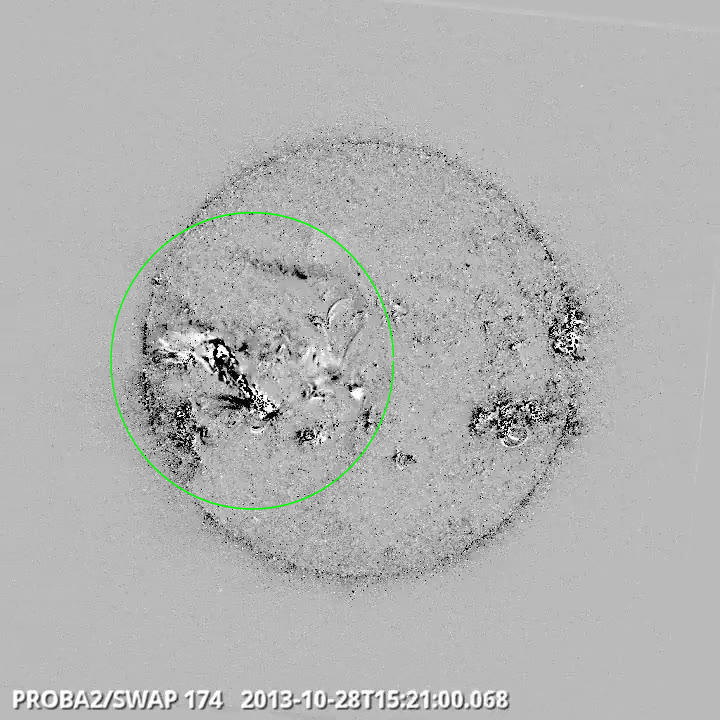
Eruption and EIT wave on the east half @ 15:21 - SWAP difference image
Find a movie of the events here (SWAP difference movie)
http://proba2.oma.be/swap/data/mpg/movies/WeeklyReportMovies/WR188_Oct28_Nov03/Events/20131028_EruptionEITwave_SouthEastQaud_1521_swap_diff.mp4
Find a movie of the events here (SWAP movie)
http://proba2.oma.be/swap/data/mpg/movies/WeeklyReportMovies/WR188_Oct28_Nov03/Events/20131028_EruptionEITwave_SouthEastQaud_1521_swap_movie.mp4
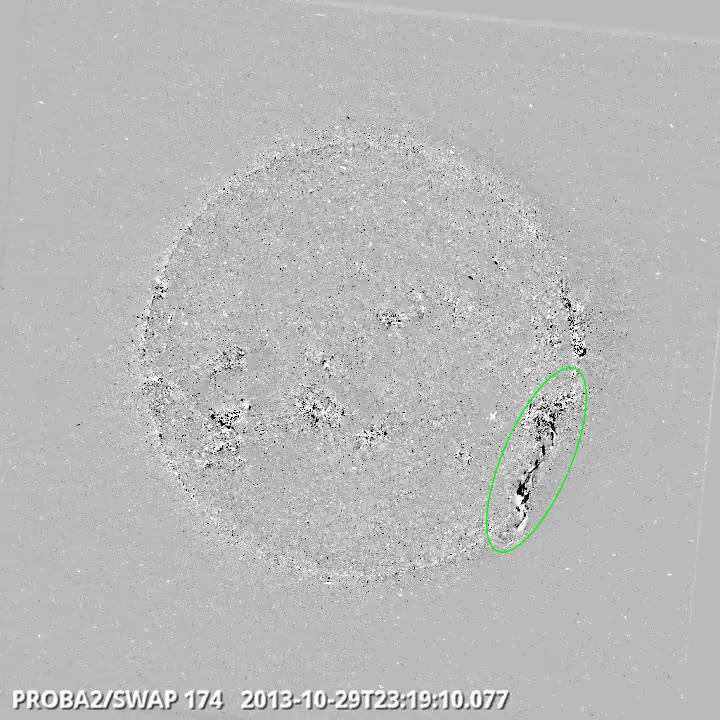
Flow on south west quad @ 23:19 - SWAP difference image
Find a movie of the event here (SWAP difference movie)
http://proba2.oma.be/swap/data/mpg/movies/WeeklyReportMovies/WR188_Oct28_Nov03/Events/20131029_Flow_SouthWestQuad_2319_swap_diff.mp4

Eruption on south east limb @ 09:48 - SWAP difference image
Find a movie of the event here (SWAP movie)
http://proba2.oma.be/swap/data/mpg/movies/WeeklyReportMovies/WR188_Oct28_Nov03/Events/20131030_Eruption_WestSouth_0948_swap_movie.mp4

Flow on the south west limb @ 05:17 - SWAP difference image
Find a movie of the event here (SWAP movie)
http://proba2.oma.be/swap/data/mpg/movies/WeeklyReportMovies/WR188_Oct28_Nov03/Events/20131031_Flow_SouthWestLimb_0517_swap_movie.mp4
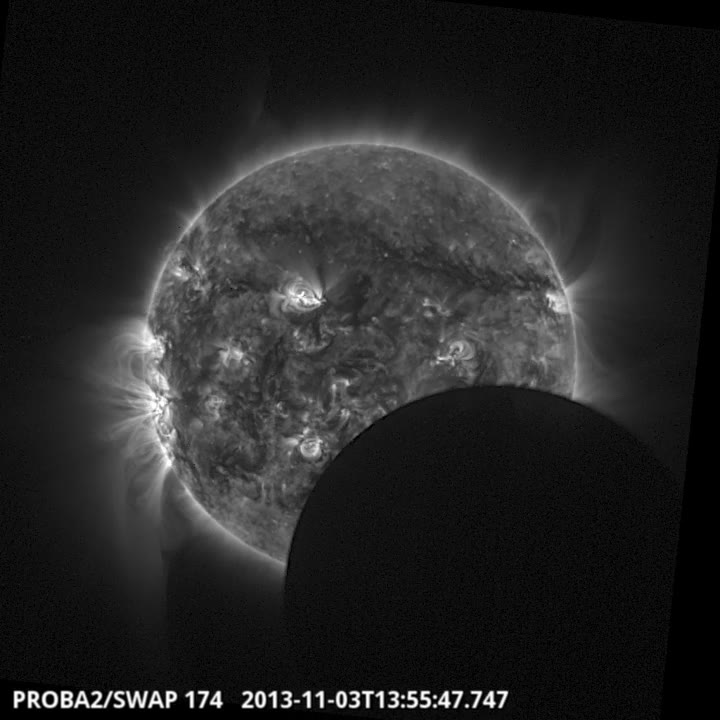
Partial solar eclips @ 13:55 - SWAP difference image
Find a movie of the event here (SWAP movie)
http://proba2.oma.be/swap/data/mpg/movies/WeeklyReportMovies/WR188_Oct28_Nov03/Events/20131103_Eclips_1355_swap.mp4
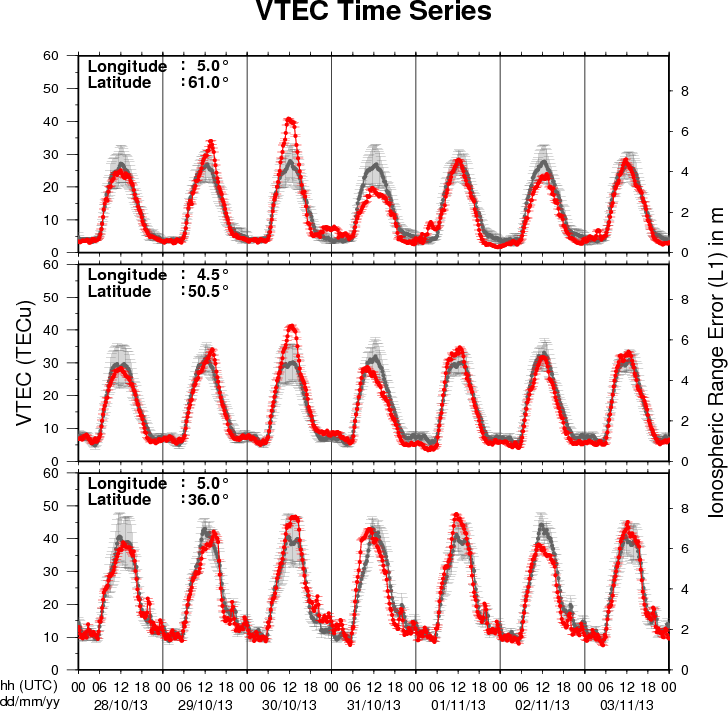
The figure shows the time evolution of the Vertical Total Electron Content (VTEC) (in red) during the last week at three locations:
a) in the northern part of Europe(N61°, 5°E)
b) above Brussels(N50.5°, 4.5°E)
c) in the southern part of Europe(N36°, 5°E)
This figure also shows (in grey) the normal ionospheric behaviour expected based on the median VTEC from the 15 previous days.
The VTEC is expressed in TECu (with TECu=10^16 electrons per square meter) and is directly related to the signal propagation delay due to the ionosphere (in figure: delay on GPS L1 frequency).
The Sun's radiation ionizes the Earth's upper atmosphere, the ionosphere, located from about 60km to 1000km above the Earth's surface.The ionization process in the ionosphere produces ions and free electrons. These electrons perturb the propagation of the GNSS (Global Navigation Satellite System) signals by inducing a so-called ionospheric delay.
See http://stce.be/newsletter/GNSS_final.pdf for some more explanations ; for detailed information, see http://gnss.be/ionosphere_tutorial.php
Start : 2013-11-11 - End : 2013-11-22
Magnetic fields play an important role in many astrophysical
processes. But magnetic are difficult to detect and to model or
understand, since the fundamental equations describing the behavior
of magnetized plasmas are highly non-linear. Hence, magnetic fields
are often an inconvenient subject which is overlooked or simply
neglected. Such difficulty burdens the research on magnetic fields,
which has evolved to become a very technical subject, with many
small disconnected communities studying specific aspects and
details.
The school tries to amend the situation by providing a unifying
view of the subject. The students would have a chance to understand
the behavior of magnetic fields in all astrophysical contexts, from
cosmology to the Sun. From star-bursting regions to AGNs in
galaxies. The school will present a balanced yet complete review of
our knowledge. Extensions into the unknown are also important to
indicate present and future lines of research.
The Winter School will bring together in a relaxed working
atmosphere a number of the leading scientists in this field, PhD
students and recent postdocs. The conditions for a successful
interaction will be granted, including two special sessions for
those students that want to present their own work.
Website:
http://www.iac.es/winterschool/2013/
Start : 2013-11-12 - End : 2013-11-15
Since its launch in Sep-2006, more than 600 refereed papers have
been published based on Hinode observations, presenting many new
and important findings to the scientific community. However, due to
the unexpectedly low levels of solar activity, until now the focus
has mainly been on the more quiescent aspects of the solar cycle.
With the solar maximum expected this year, through cooperative
observations with SDO, IRIS, and ground based observatories, Hinode
observations should lead to our understanding of active Sun
phenomena, such as solar flares and CMEs, to be greatly improved.
Making Hinode-7 an excellent opportunity to discuss solar activity
in the current solar cycle and the related science through the use
Hinode data, as well as other solar/space weather data. It will
also be interesting to use this meeting to broaden our focus to
include the solar-stellar connection as a means to deepen our
understanding of solar activity.
Momentum is also gaining for Solar-C, which is being developed
as an international collaboration between Japan, US and Europe. To
further discuss this mission, the Solar-C science meeting will be
held on 11-Nov.
Website:
http://www.kwasan.kyoto-u.ac.jp/hinode-7/
Start : 2013-11-13 - End : 2013-11-13
Most space weather occurs due to the Sun's emissions which
can affect the Earth's space environment. Modern society is
ever more dependent upon ground-based & spaceborne technology
which can be vulnerable to space weather. Satellites, GPS, aviation
& the electric power industry are all at risk from this &
hence space weather is now included on the UK's National Risk
Register. It is important to have long-running, continuous
observations for forecasting, nowcasting & for research in
space weather. This public meeting, held during the peak of the 11
year solar cycle, addresses the deficiency in continuous, long-term
observations & how this might be overcome.
Website:
http://www.rmets.org/events/space-weather-importance-observations
Start : 2013-11-18 - End : 2013-11-22
This International CAWSES-II Symposium hosted by SCOSTEP
(Scientific Committee on Solar-Terrestrial Physics) will provide an
excellent opportunity to discuss the scientific accomplishments of
CAWSES-II and look forward to SCOSTEP's future programs at a moment
toward the end of its five-year period. The symposium will cover
the six major themes of CAWSES-II tasks: 1) What are the solar
influences on the Earth's climate?, 2) How will geospace respond to
an altered climate?, 3) How does short-term solar variability
affect the geospace environment?, 4) What is the geospace response
to variable inputs from the lower atmosphere?, 5) Capacity
Building, 6) Informatics and eScience. The main functions of
CAWSES-II are to help coordinate international activities in
observations, modeling, and applications crucial to achieving this
understanding, to involve scientists in both developed and
developing countries, and to provide educational opportunities for
students of all levels. The symposium offers keynotes/lectures that
will be interesting for all participants every morning and more
specific sessions of presentations in the afternoon. We welcome all
those who are involved and/or interested in CAWSES-II to Nagoya in
the autumn when we will have the pleasure of being surrounded by
beautiful colorful leaves of this season.
Website:
http://www.cawses.org/CAWSES/leaflet_CAWSES-II_120229.pdf
Start : 2013-11-18 - End : 2013-11-22
The 10th Edition of the European Space Weather
Week will take place on 18-22nd
November 2013 in Belgium. The venue will be confirmed early next
year, but mark your calendars now for the 10th Anniversary of this
growing European event.
The ESWW will again adopt the central aim of bringing together
the diverse groups in Europe working on different aspects of Space
Weather
. This includes but isn't
limited to the scientific community, the engineering community,
applications developers, service providers and service end users.
The meeting organisation will again be coordinated by the Belgian
Solar-Terrestrial Centre of Excellence (STCE), ESA
and the Space Weather
Working Team. The local
organisation will be done by the STCE.
Website:
http://www.stce.be/esww10/
Start : 2013-11-26 - End : 2013-11-28
The 1st SPRING (Solar Physics Research Integrated Network Group)
workshop is being held from November 26 - 28, 2013 at the scenic
Brugger's Hotel Park by Titisee hosted by the Kiepenheuer-Institut
für Sonnenphysik in Freiburg, Germany.
The purpose of the workshop is to work on the scientific
requirements for a new ground-based network of telescopes for
full-disk synoptic observations of the Sun.
The desire for such a new network is motivated by new scientific
research directions in solar physics, the requirement of real-time
context data for high-resolution solar telescopes, and the need of
continuous, long-term, consistent, and reliable solar data as
foundation for space weather prediction.
Website:
http://www3.kis.uni-freiburg.de/~mroth/spring.html
Start : 2013-12-13 - End : 2013-12-13
The inclusion of space weather in the National Risk Assessment
in 2012 means that there is now an urgent need for dialogue between
those doing the science of space weather and those using the data
to forecast, understand and mitigate the risks.
Since the Sun is currently at the peak of its cycle - a time
when space weather events become more frequent - we have a timely
opportunity to study how a range of solar activity ultimately lead
to magnetospheric, ionospheric and ground level disturbances.
The goal of this meeting is to bring together those working
across the broad range of space weather activities in the UK to
discuss the current status of observations and recent new advances
in the theories and models of the phenomena of space weather.
Website:
http://www.mssl.ucl.ac.uk/~lmg/spaceweather/Overview.html
Start : 2013-12-16 - End : 2013-12-20
Scientific sessions:
Website:
http://tesis.lebedev.ru/workshop2013.html
Start : 2014-01-28 - End : 2014-01-31
We are pleased to announce the 2014 SORCE Science Meeting,
motivated by the NASA/EOS Solar Radiation and Climate Experiment
(SORCE). The agenda for this interactive meeting consists of
invited and contributed oral and poster presentations concerning
variations in the Sun's radiation and in the Earth environment. We
encourage your participation and hope that you will share this
announcement with colleagues.
Website:
http://lasp.colorado.edu/home/sorce/news-events/meetings/2014-sorce-science-meeting/
Start : 2014-02-10 - End : 2014-02-11
The International Space Weather Initiative (ISWI), with the
support of the United Nations Committee for the Peaceful Uses of
Outer Space, has been very active in promoting the installation of
new ground-based instrumentation in non-traditional locations. In
particular, there has been substantial progress in the observation
of the equatorial ionosphere, solar transients, and energetic
particles from space. In the coming decade these observations will
become available in real time and will be an important new data
source for the forecasting of space weather events. New instruments
are either in the process of deployment, or planned over the next
decade. Similarly, the International Living with a Star (ILWS)
program has been very active coordinating the plans of the world's
space agencies in the planning of new space missions, and in the
development of space weather modeling and forecasting.
Website:
http://newserver.stil.bas.bg/ISWI/Meetings/Cevents.html#item12
Start : 2014-03-16 - End : 2014-03-22
The meeting brings together scientists working in solar physics,
space physics, plasma physics, and astrophysics, in theory,
simulations, and experiment. The objective is to report and discuss
recent progress in our understanding of the fundamental processes
in solar, space, and astrophysical plasmas, in view of heliospheric
in-situ and remote sensing measurements (Van Allen Probe, Themis,
Cluster, Stereo, SDO, Messenger, Cassini, Venus-Express) and remote
sensing astrophysical observations (Chandra, XMM-Newton, Swift and
Fermi Gamma-ray Telescope).
Website:
http://physics.bgu.ac.il/~gedalin/Isradynamics2014/
Start : 2014-06-23 - End : 2014-06-27
The meeting in honour of Prof. Zdenek Svestka will cover issues
of the physics of solar and stellar flares.
Website:
http://solarflares2014.cz/
Start : 2014-08-02 - End : 2014-08-10
The 40th COSPAR Scientific Assembly will be held in Moscow,
Russia from 2 - 10 August 2014. This Assembly is open to all bona
fide scientists.
Website:
http://www.cospar-assembly.org/
Start : 2014-08-31 - End : 2014-09-05
Low-frequency waves (ULF, ELF and VLF) in space plasmas have
been studied for many decades. In our solar system, such waves
occur in the magnetospheres of planets and in the solar wind; more
recently they have also been confirmed on the Sun. In spite of the
great differences in the plasma properties of these regions, the
overarching schemes are wave generation, wave propagation, and wave
dissipation, which are three fundamental aspects of any kind of
waves. A fourth aspect of these waves is their application, either
with direct benefit to humans or for scientific pursuit. Therefore,
this Chapman conference will provide a forum in which various wave
communities can come together and discuss recent achievements of
observational, theoretical, and modeling studies.
Website:
http://chapman.agu.org/spaceplasmas/
Start : 2014-09-08 - End : 2014-09-12
The European Solar Physics Meetings aim to highlight all aspects
of modern solar physics, including observation and theory that span
from the interior of the Sun out into the wider heliosphere. These
meetings provide a broad, yet stimulating, environment for European
and international scientists to share their research in solar
physics.
The meeting will mostly comprise of contributed talks and poster
presentations, with several invited review talks (typically one per
session). Posters will be on display for the whole meeting in close
proximity to the lecture theatre. Refreshments will be served in
the poster viewing area during two dedicated coffee/poster breaks
on each full day.
Website: http://www.espm14.ie/
Start : 2015-06-22 - End : 2015-06-26
The Fourteenth International Solar Wind Conference will be held
for the first time ever in China, from 22 to 26 June 2015, at
Weihai in the Shandong province. It will be jointly organized by
the School of Earth and Space Sciences of Peking University and the
newly-established Institute of Space Sciences of Shandong
University. The meeting will take place in the Space Science
Building of Shandong University, a venue located within walking
distance to the beautiful Weihai International Bathing Beach, one
of the most popular scenic areas of northern China.
The conference will cover all aspects of solar wind physics,
with invited reviews and contributed papers that examine the
current research and outline the future research in all the
relevant solar wind fields.
Website: not available yet